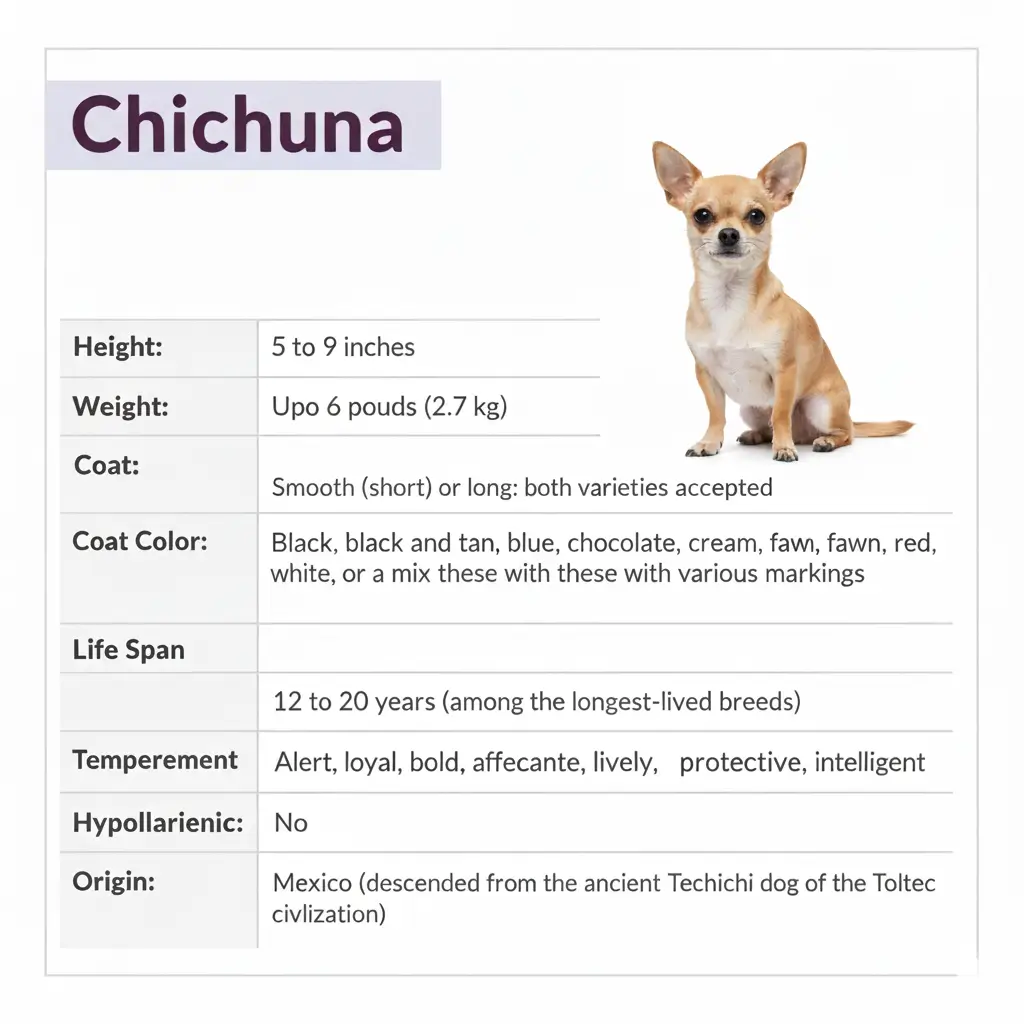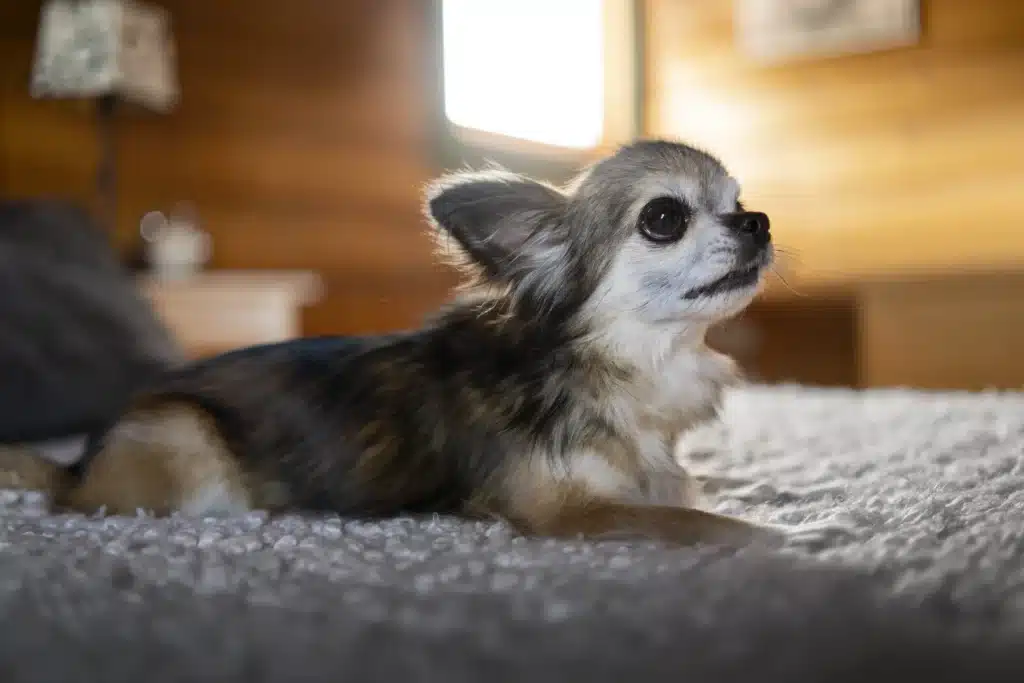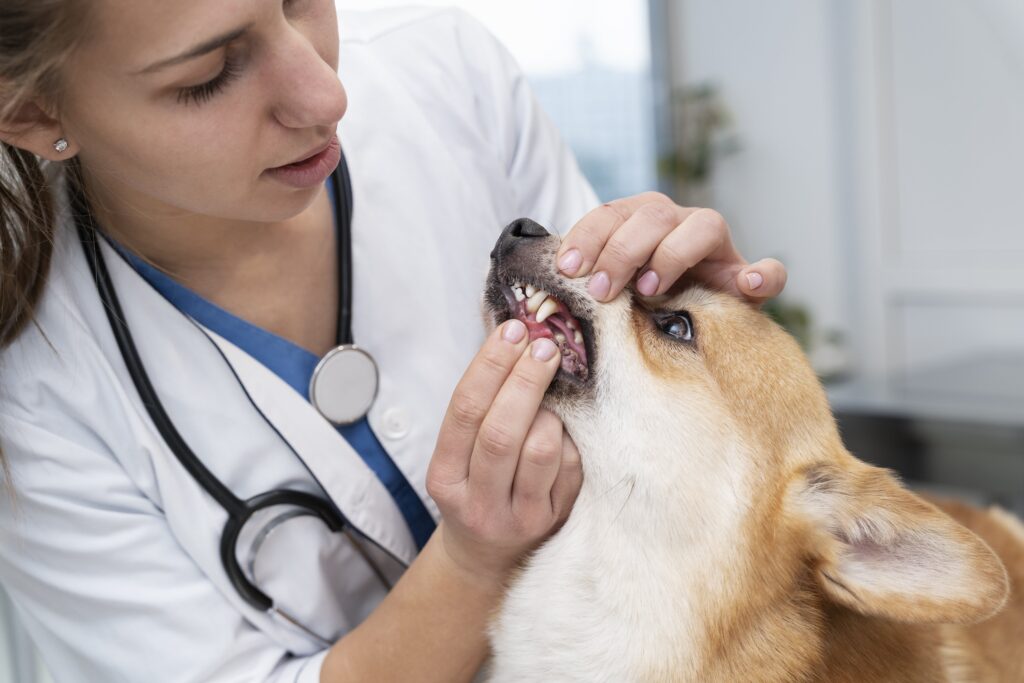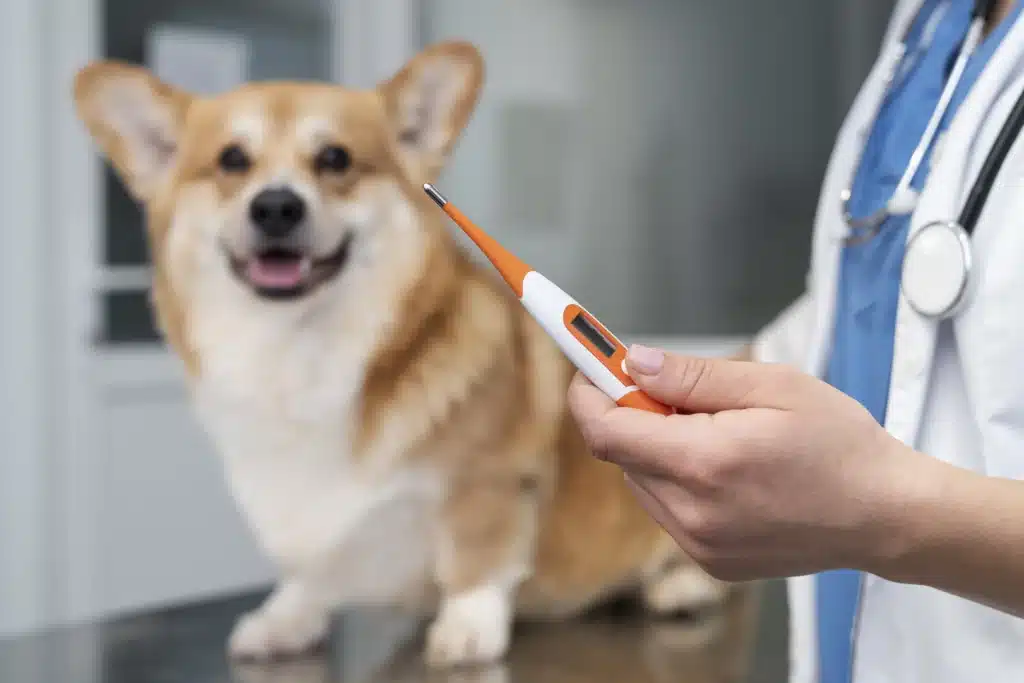What is a Chihuahua?
The Chihuahua is the world’s smallest dog breed, weighing no more than 6 lbs (≈ 2.7 kg) and standing 5–9 inches tall. Classified in the Toy Group by the American Kennel Club (AKC), this breed is known for its apple-shaped or deer-shaped head, erect ears, and large, expressive eyes (AKC Breed Standard). Despite its tiny size, the Chihuahua is famous for its confidence, loyalty, and long lifespan.

Where Do Chihuahuas Come From?
The Chihuahua has origins in Mexico and likely descends from the Techichi, a small companion dog of the Toltec civilization. Spanish conquistadors documented small dogs in the region of present-day Chihuahua state, giving the breed its modern name. The AKC officially recognized the Chihuahua in 1904, making it one of the earliest registered toy breeds in the U.S.
What is the Temperament of a Chihuahua?
The Chihuahua is devoted, alert, and spirited. Owners often describe them as “big dogs in small bodies.”
- They form strong bonds with one or two family members.
- They can be protective and vocal, warning of strangers.
- They are intelligent, curious, and enjoy both playtime and companionship.
According to the American Veterinary Medical Association (AVMA, 2022), small breeds such as the Chihuahua are increasingly popular among city residents due to their adaptability to apartment life (AVMA Pet Ownership Data).

How Long Do Chihuahuas Live?
The average Chihuahua lifespan is 14–16 years; they’re actually one of the longest-living dog breeds.
What Health Problems Do Chihuahuas Have?
Chihuahuas are generally resilient and long-lived, but like many toy breeds, they are predisposed to several health issues due to their small size and anatomy. The most common concerns include dental disease, orthopedic disorders, airway conditions, heart disease, hypoglycemia, and eye-related issues.
Chihuahua Health Problems at a Glance
1. Dental Disease
Dental disease is one of the most frequent problems in Chihuahuas. Their small jaws cause tooth overcrowding, which traps food particles and leads to plaque and tartar buildup. If untreated, this progresses to periodontal disease, which can cause pain, tooth loss, and systemic infections.
According to Cornell University College of Veterinary Medicine, over 80% of small-breed dogs develop dental disease by age 3.
Prevention: Daily brushing, dental chews, and professional cleanings.

2. Patellar Luxation
Patellar luxation occurs when the kneecap (patella) slips out of its groove, leading to limping or a “skipping gait.” Toy breeds, including Chihuahuas, are at higher risk. Chronic cases can cause arthritis and reduced mobility.
A study published in the Journal of Small Animal Practice reported patellar luxation prevalence above 1.3% in small-breed dogs (PubMed Reference).
Prevention & Management: Weight control, joint supplements, and corrective surgery for severe cases.
3. Tracheal Collapse
Tracheal collapse happens when weakened cartilage in the windpipe causes airway narrowing. Affected Chihuahuas often produce a “goose-honk cough”, especially when pulling on a collar or excited.
The American College of Veterinary Internal Medicine (ACVIM) notes tracheal collapse is common in toy breeds and recommends weight management and harness use instead of collars.
Prevention & Management: Walk with a harness, avoid obesity, and manage allergens.
4. Heart Conditions
Chihuahuas are predisposed to:
- Mitral Valve Disease (MVD): A progressive condition leading to congestive heart failure.
- Patent Ductus Arteriosus (PDA): A congenital defect that overloads the heart and lungs.
The ACVIM Consensus Guidelines on Heart Disease recommend early detection through heart murmur screening in small breeds.
Symptoms: coughing, fatigue, exercise intolerance, fainting, or breathing difficulty.
5. Hypoglycemia
Due to their tiny body mass, Chihuahua puppies are prone to hypoglycemia (low blood sugar). Symptoms include trembling, lethargy, seizures, or collapse.
The American Kennel Club (AKC) explains hypoglycemia is common in toy-breed puppies and requires frequent feeding.
Prevention: 3–4 small meals daily, high-quality puppy food, and monitoring during growth.

6. Eye Issues
Chihuahuas’ large eyes make them prone to several inherited and acquired conditions:
- Dry Eye (Keratoconjunctivitis Sicca) – inadequate tear production.
- Glaucoma – high eye pressure leading to blindness if untreated.
- Cataracts – lens clouding, often age-related.
The American College of Veterinary Ophthalmologists (ACVO) highlights toy breeds, including Chihuahuas, as high-risk for inherited eye diseases.
Prevention: Routine eye checks, trimming hair around the eyes, and early veterinary screening.
How Should You Feed a Chihuahua?
You should feed a Chihuahua according to its life stage—puppy, adult, or senior—while ensuring portion control and nutrient balance. Below is the recommended feeding schedule, the rationale behind it, and key guidelines based on veterinary and canine nutrition authority sources.
Chihuahua Feeding Guide
| Life Stage | Meals per Day | Portion Size (approx.)* | Key Nutritional Needs | Notes / Vet Guidance |
| Puppy (up to 12 months) | 3–4 meals (some <3 months may need 4–6) | ¼ – ½ cup daily (divided) | High protein (22–32%), fat (10–25%), DHA for brain development | Frequent meals prevent hypoglycemia. Use a small-breed puppy formula. AKC Puppy Feeding Guide |
| Adult (1–7 years) | 2 meals daily (some benefit from 3 smaller meals) | ¼ – ½ cup daily (divided) | Protein ~18–25%, fat ~10–15%, balanced carbs, omega fatty acids | Small-breed kibble size aids chewing and helps reduce plaque. Watch calories to prevent obesity. PetMD Dog Nutrition |
| Senior (7+ years) | 2 meals daily (smaller, more frequent meals if sensitive digestion) | ¼ cup daily (divided, adjust for weight) | Lower calories, moderate protein, joint supplements (omega-3, glucosamine), antioxidants | Monitor weight closely. Senior formulas may support heart and joint health. AVMA Pet Nutrition |
Puppies: 3–4 Small Meals Daily to Avoid Hypoglycemia
Chihuahua puppies should eat 3 to 4 small meals per day to maintain stable blood sugar and support rapid growth.
- Toy-breed puppies have high metabolic demands and limited energy reserves, making them more vulnerable to hypoglycemia (low blood sugar) if they go too long without food.
- According to Puppy Feeding Fundamentals small and toy breed puppies often require 3 to 4 feedings a day before transitioning into fewer, larger meals as they mature.
- In early months (under ~3 months), some expert guides suggest 4–6 times daily for the smallest puppies to avoid energy crashes.
Expansion & Variations:
- As puppies reach 4–6 months, many can reduce to 3 feedings per day, and eventually transition to 2 as they near maturity.
- Always monitor for symptoms such as weakness, tremors, or lethargy—if they appear, offer a small snack (e.g., sugar solution or vet-recommended treat) and contact your vet immediately.
- Use a complete & balanced puppy formula designed for small breeds, as nutritional needs in protein, fat, and micronutrients differ from adult formulas.
Adults: 2 Meals per Day with High-Quality Small-Breed Food
Adult Chihuahuas should be fed two meals per day using nutrient-dense food formulated for small breeds.
- After the puppy stage (usually around 9–12 months, depending on the dog), most dogs do well on two balanced meals daily—morning and evening.
- Small-breed formulated kibble has smaller kibble size, higher energy density, and the appropriate nutrient ratio to meet their metabolic needs.
- Opting for dry kibble offers an additional benefit: the abrasion action helps slow plaque and tartar formation on teeth. While not a substitute for dental care, the mechanical effect is acknowledged in nutrition guides.
Expansion & Variations:
- Some adult Chihuahuas may benefit from two to three meals, especially if prone to mid-day energy dips, but avoid overfeeding.
- Portion sizes should be determined by body condition, not just caloric charts. The AKC’s e-book on puppy nutrition emphasizes “watch the dog, not the dish.”
- Avoid free-feeding (leaving food available all day), which risks obesity in toy breeds.
Seniors: Monitor Weight; Obesity Worsens Heart & Joint Problems
Senior Chihuahuas should continue on 2 meals daily, but portions and nutritional density often need adjustment to prevent weight gain and maintain lean muscle.
- As metabolism slows with age, maintaining ideal body condition becomes critical to reduce stress on the heart and joints.
- The Greenville Humane Society feeding guidelines suggest adult dogs typically are fed twice daily, with adjustments based on health and body condition.
- Senior formulas with lower calorie density but quality protein and joint-supporting nutrients (like omega-3s) may be appropriate, depending on health status.
Expansion & Variations:
- Monitor changes in activity, appetite, and weight monthly. Sudden changes may indicate dental problems, metabolic disease, or underlying illness.
- In some cases, older dogs may benefit from smaller, more frequent meals (3 per day) if they have digestive sensitivity.
- Always consult your vet before switching to a senior or therapeutic diet.
Additional Feeding Principles & Guidelines
- Portion Control Is Essential: The AKC warns that even a few extra calories can cause obesity in toy breeds.
- Food Selection Matters: Choose formulas labeled “complete and balanced” for the dog’s life stage and breed size. Prioritize real meat protein sources and avoid high fillers.
- Transitioning Food: Gradually transition (over 7–10 days) when changing diets to avoid gastrointestinal upset.
- Avoid Excess Treats: Treats should make up no more than 10% of daily caloric intake.
- Hydration Always: Fresh clean water must always be accessible, especially when feeding dry kibble.
- Consult Your Vet: Use food provider recommendations as starting points, but always tailor feeding to your dog’s body condition, health needs, and activity level.
How Do You Groom a Chihuahua?
- Smooth Coat: Brush weekly, bathe as needed.
- Long Coat: Brush 2–3 times weekly, trim hair around eyes and ears.
- Dental Care: Daily brushing recommended.
- Nails & Ears: Monthly nail trims; occasional ear cleaning.

How Do You Train a Chihuahua?
Chihuahuas are intelligent but stubborn. Positive reinforcement is the most effective method.
- House Training: Consistency is critical; small bladders mean frequent potty breaks.
- Socialization: Early exposure to people and pets prevents anxiety and reactivity.
- Basic Commands: Improves obedience and reduces excessive barking.
The AKC Canine Good Citizen Program recommends obedience training for toy breeds to build confidence and reduce problem behaviors (AKC Training).
Are Chihuahuas Good for Apartments?
Yes. Chihuahuas adapt extremely well to apartments and city life. They require 20–30 minutes of daily activity and thrive when close to their owners. However, they are fragile and should be supervised around small children and large dogs.
Conclusion
The Chihuahua is a loyal, spirited, and long-living breed, perfect for city dwellers and families who can dedicate time to training and companionship. From its ancient Mexican roots to its modern reputation as a feisty yet loving lap dog, the Chihuahua thrives when given proper health care, nutrition, and affection.
FAQs
Q1. How much does a Chihuahua weigh?
Under 6 lbs (≈2.7 kg) according to AKC standards.
Q2. Do Chihuahuas bark a lot?
Yes. They are alert and protective, but training can reduce excessive barking.
Q3. Are Chihuahuas hypoallergenic?
No. They shed lightly and still produce allergens.
Q4. How much does a Chihuahua cost?
$800–$2,000 from breeders; less through shelters or rescues.
Q5. Why do Chihuahuas shake?
Common causes are cold, anxiety, hypoglycemia, or medical issues like hydrocephalus.
Q6. Are Chihuahuas good for families with kids?
Yes, but best with older children who know how to handle small dogs safely.
Q7. Do Chihuahuas get along with cats?
Often yes, if introduced gradually and supervised.
Q8. How much exercise does a Chihuahua need?
About 20–30 minutes daily plus indoor play.


